 A unique gold and enamel heart-shaped pendant bearing the initials and emblems of King Henry VIII and Katherine of Aragon has been unveiled at the British Museum. It is in impeccable condition and of such exceptionally high quality that it could plausibly be connected to the royal couple themselves.
A unique gold and enamel heart-shaped pendant bearing the initials and emblems of King Henry VIII and Katherine of Aragon has been unveiled at the British Museum. It is in impeccable condition and of such exceptionally high quality that it could plausibly be connected to the royal couple themselves.
The jewel was discovered by Birmingham café owner Charlie Clarke while metal detecting in a field in Warwickshire on a very auspicious Friday the 13th, December, 2019. After his screaming abated, Clarke notified the Finds Liaison Officer who in turn contacted Historic England. A subsequent excavation of the find site did not return any further artifacts.
The pendant is a heart-shaped locket enameled in red and white on both sides. The obverse is decorated with an engraved floral design in the center. Accented with translucent red enamel leaves, the stalk splits into two with a red and white enamel Tudor rose on the left and a pomegranate, emblem of Katherine of Aragon, on the right.
The reverse features a central design of an “H” and a “K” in Lombardic script entwined with a ribbon. The initials are enamelled in red, the ribbon with white. The ribbon ends with a thistle-shaped tassel in red and white enamel.
Both sides have a banner unfurled at the bottom inscribed with red enamel lettering reading: + TOVS + IORS. That same inscription is on the reverse of the pendant under the initials only with black enamel. This is the French “toujours” (meaning “always”) broken into two parts. Iterations of this inscription have been found on other pieces from the post-medieval period, for example this simple gold posy ring from the 16th or 17th century inscribed on the inner band: + TOVT IOVRS LOIALL (“forever faithful”). Rachel King, curator of Renaissance Europe at the British Museum, thinks the pendant’s inscription may also be a play on words, splitting “toujours” into “tous” (French for “all”) and “iors,” which is phonetically the same as the English “yours.”
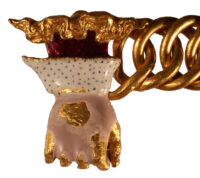 The chain consists of 75 links for a total length of 17.2 inches. At one of the chain is a red and white enamelled, begloved hand at one end. The hand is clenched in a fist with fingers curved back under the thumb flat against the side. The cuff of the glove is white enamel with black speckles suggesting ermine trim. A rectangular sleeve decorated in translucent red enamel extends past the cuff. The other end of the chain was modified at some point to create a hinged clasp behind the glove.
The chain consists of 75 links for a total length of 17.2 inches. At one of the chain is a red and white enamelled, begloved hand at one end. The hand is clenched in a fist with fingers curved back under the thumb flat against the side. The cuff of the glove is white enamel with black speckles suggesting ermine trim. A rectangular sleeve decorated in translucent red enamel extends past the cuff. The other end of the chain was modified at some point to create a hinged clasp behind the glove.
The whole necklace, chain and pendant, weighs 317 grams of 24K gold. It is very high in gold content even in its most minute parts. The suspension loop, hinges, wire border are more than 98% gold, with just a trace of silver and a soupçon of copper.
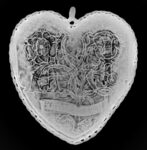 British Museum researchers were able to narrow down the date of the pendant based on the Lombardic script and decorative motifs. It was made later than 1509 and before 1530. That fits the political timeline as well. Henry married Katherine in 1509 and banished Katherine from court in 1531, so the market for entwined H&K initials on heart jewels came to a screeching halt at that time. Their marriage was annulled in 1533.
British Museum researchers were able to narrow down the date of the pendant based on the Lombardic script and decorative motifs. It was made later than 1509 and before 1530. That fits the political timeline as well. Henry married Katherine in 1509 and banished Katherine from court in 1531, so the market for entwined H&K initials on heart jewels came to a screeching halt at that time. Their marriage was annulled in 1533.
Despite initially seeming almost too good to be true, said King, careful scientific analysis has proved the pendant to be genuine. What experts have not been able to uncover, however, despite scouring inventories and pictures of the time, is to establish a personal link to Henry or Katherine.
“Nonetheless, its quality is such that it was certainly either commissioned by or somehow related to a member of the higher nobility or a high-ranking courtier.”
One hypothesis, based on careful analysis of its iconography and other historical records, is that the pendant may have been commissioned to be worn or even given as a prize at one of the major tournaments of which Henry was so fond, around the time of the famous Field of the Cloth of Gold in 1520. Though its size suggests it would only fit a woman, it may not have been meant to be worn at all.
Nothing remotely similar survives from the period, said King. “In the British Museum, we’ve got the largest collection of objects from the early Tudor periods in precious metal; none of them are anything like this.”
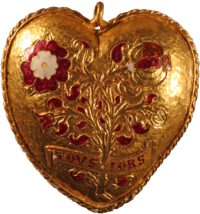
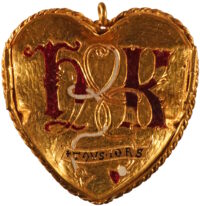
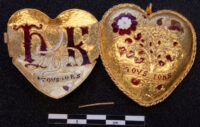
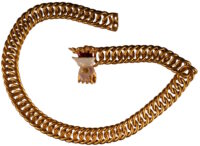
” –Go forth now, and bury his heart in a fielde in Warwickshire!”
TO IOVRS LOYALL
How do you tell the age of Henry VIII in portraits!
Count his rings
Interesting item. It’s hard to believe that it could be lost for so long. From pictures, it is a beautiful item. Any value and was there a finder’s fee. As a U.S. citizen, I haven’t had access to anything like that. When I was younger, my father was stationed at the U.S. Army Hospital in Landstuhl, Germany. Each summer, we took a week off to travel all over Europe. We saw many castles in Germany and many beautiful items in Rome. We went down into the catacombs. Many, many memories travelling and with my parents. They’re gone now as are my 2 sisters.
@James – According to the linked article, the “pendant has not been valued yet but seems worth a highly significant sum, which Clarke will split with the landowner of the field”.
Therefore, notably in addition to defining ‘Treasure’ as such, the “UK Treasure Act allows for a reward up to the market value to be shared among the finder and the tenants and/or owner of the land on which the treasure was found. The amount of the reward and how it is divided among the claimants is determined by the Treasure Valuation Committee.”
Also, there might be even a connection to Warwickshire:
In 1499, due to reason of state, 24y-old “Edward Plantagenet, 17th Earl of Warwick was beheaded. Henry VII paid for the body and head to be taken to Bisham Abbey in Berkshire, using funds derived from Edward’s estate. It was thought at the time that Warwick was executed in response to pressure from Ferdinand II of Aragon and Isabella I of Castile, whose daughter, Catherine of Aragon, was to marry Henry VII’s heir, Arthur, in 1501.”
After Arthur’s death in 1502, Henry VIII married Katherine in 1509, but “Catherine was said to feel very guilty about Warwick’s death, and believed that her trials in later life were punishment for it.” It might be worth noticing, however, that at least she would be able to keep her royal head on her shoulders.
Even if Henry VIII had wanted to do away with Katherine of Aragon and it probably crossed his mind a few times, but Katherine was a royal princess from Spain with royal blood and very powerful parents so for Henry to have had her executed i believe that the Spanish might have invaded England and that was something that Henry VIII wouldn’t have wanted, so instead he made her life a misery and left her in solitude to die alone with just a few of her female companions her daughter Mary forbidden to see her, this was punishment for them both. Katherine wouldn’t grant him an annulment or a divorce as it would’ve gone against everything she believed in.
And that started Protestantism. Divorces, multiple wives. King Henry Vlll was a sick dirty old man that had no regard of of people’s lives. The title King and The Crown were tarnished forever.
But James…you have wonderful memories. A blessing.
We were Air Force and stationed at Rhein Main in the 1960’s. We traveled a lot and much to my regret never made it to England. I am obsessed with English History and particularly the Tudor period.
You must have some wonderful memories. Gone but not forgotten
Does anyone know how it was found? Was he sea using a metal detector? Just curious.
Mistyped…”Was he using a metal detector?”*
Yes he did have a metal detector but fascinating isn’t it, how this remarkable historical jewel ended up in a field in the middle of nowhere? Probably lost during someone’s travels remembering there were few roads.
My sons found it in Warwickshire . He was using a metal detector
What an incredible find. How very exciting!!
Yes he was . My Sons friend found it
Hello Lorraine,I was wondering if they found it around the castle grounds?It was amazing to see it .I have read about it before on ancestry site.Cathrine De Aragon is my 15th.great aunt.I hope they donated to a museum.Thank you for your time, Maureen Ramage
The article says that yes, he was using a metal detector.
I never understood why he parted with Kathryn of Aragon. Because Kathryn, as her mother before her had defended her country, so had Kathryn defended England. I have read all the theories, but none impress me.
Henry wanted a male heir. State concerns always trumped personal affection.
Thank you for sharing this.It was amazing to see.I have read about it.Cathrine De Aragon is my 15th.great aunt.I heard it was found I hope it ends up in a museum so everyone can enjoy it.Thank you, Maureen
If you will notice the red rose and the white rose these represent the two royal houses of the Tudor being the red rose and the House of York being the white.
red rose is house of lancaster, white is house of york. war of the roses. i think the tudor line is out of the marriage of one rose with the other and so created the tudor rose.
The first image appears to show the pendant open, so it was a locket. Was anything found inside?
It is indeed a locket and there was nothing found inside. Here’s a photo of the interior of the open locket.
Thank your so much for sharing! This part of English history is so fascinating!
That would mean either Katherine of Aragon herself or one of her friends or servants threw it in the field. I presume it to be Katheine herself. If this is true, one can say that Katherine was in that field that day.
But Henry VIII also could have done it himself.
they arent sure it belonged to k. said it could have been a tournament prize.
This is a rare find. Catherine of Aragon suffered under King Henry the 8th.
Yes. She was treated extremely badly and died in obscurity. She was denied much of her jewelry by Ann Bolin. Perhaps this was a piece taken by Bolin and given to a servant for a favor, or thrown away out of jealousy. There was much discord between Ann, Katherine and Mary.
Do archaeologists ever peer into the past with the assistance of psychics? This could possibly reveal how the jewel ended up in the field.
Katherine loved Henry til the end. She died three years after their marriage was declared null. This beautiful locket would be worn next to her heart ~ steadfast dedication to her vow of devotion.